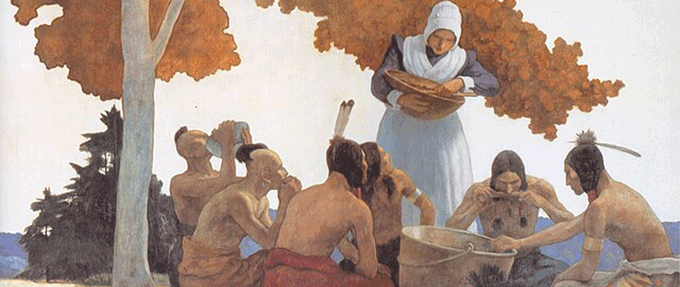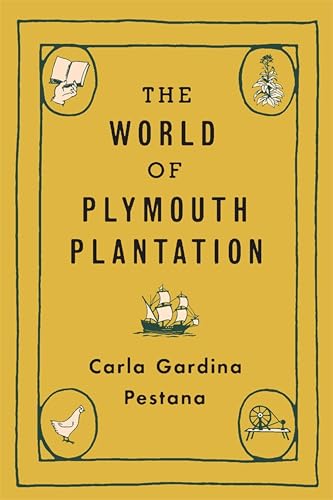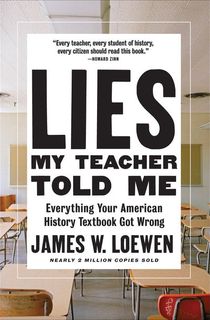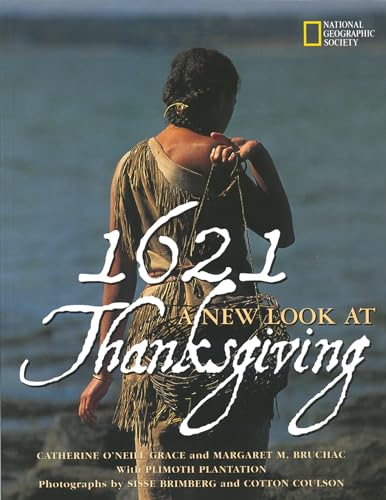The image of the First Thanksgiving is deeply ingrained in the American consciousness: a harmonious gathering where Pilgrims and Native Americans shared a peaceful, bountiful feast before the Indigenous people graciously "disappeared," conceding the land to the newcomers.
This seemingly simple, heartwarming painting of American history is the foundation of a national holiday built on unity and gratitude. Yet, as historians have meticulously documented, this picture is largely a cautiously constructed myth—one that obscures a far more complex history.
The actual events of the feast of 1621 were far less harmonious than the school play version. Was the Wampanoag tribe’s attendance at this “feast” an act of friendship, or a desperate move for survival after facing devastating disease? Was the gathering a warm celebration of family and community, or an uneasy diplomatic meeting between two groups driven by self-interest?
And did that iconic table even have turkey, pumpkin pie, and cornbread on it?
This article, informed by the work of scholars like David J. Silverman in This Land is Their Land and James W. Loewen in Lies My Teacher Told Me, strips away the amiable façade to reveal the true story: the tensions, the strategic compromises, and the colonial conflicts that Thanksgiving myths were designed to forget.
The current Thanksgiving narrative was formalized during one of the nation's most divisive moments. The holiday was officially established as a national tradition in 1863 by President Abraham Lincoln, urged on by persistent campaigning from magazine editor Sarah Josepha Hale.
Instituting the holiday during the height of the Civil War served a clear political purpose: it aimed to foster a sense of shared American history and promote national unity and reconciliation, deliberately simplifying the colonial past to create a unifying tradition (Lincoln Proclamation, 1863; LOC, 2021).
Here are five Thanksgiving myths that reveal just how far the legend has drifted from reality.
Myth #1: The First Thanksgiving was a friendly, harmonious feast.
Truth: The famous 1621 gathering was likely a strategic, politically motivated event driven by necessity, not innate benevolence.
As historian David J. Silverman details in his 2019 book, This Land is Their Land, the Wampanoag tribe leader Ousamequin (Massasoit) sought an alliance with the English settlers at Plymouth because his people had been decimated by a widespread epidemic disease. He saw the English as an opportunity to fend off tribal rivals.
A far cry from the narrative Silverman critiques in a Smithsonian interview: the "myth is that friendly Indians, unidentified by tribe, welcome the Pilgrims to America, teach them how to live in this new place, sit down to dinner with them and then disappear…It’s bloodless and in many ways an extension of the ideology of Manifest Destiny.”
This relationship between Wampanoags and English settlers rapidly deteriorated, culminating just decades later in one of the most brutal conflicts in colonial history: King Philip’s War.
Myth #2: Thanksgiving was about family.
Truth: The initial gathering in 1621 was, in theory a multicultural, diplomatic affair, not a celebration focused on the nuclear family unit.

The concept of Thanksgiving as an intimate, wholesome, family-oriented celebration with a standard annual menu—the version we celebrate today—developed much later, formalized in the 19th century. The original event was a harvest celebration that became a crucial public and diplomatic statement about the provisional peace between the two powers at Plymouth.
Myth #3: Most Native American tribes got along.
Truth: The historical portrait of harmonious tribes relies on dangerous generalizations about Native groups, ignoring the complex history of distinct nations and intertribal rivalries.
The decision by Wampanoag leader Ousamequin to strike a deal with the colonial powers in Plymouth was directly driven by preexisting tensions and rivalries with other Native groups in the region, as outlined by scholars like Carla Gardina Pestana in The World of Plymouth Plantation.
By lumping all Indigenous people into an "unidentified tribe" category, the historical narrative ignores the specific, high-stakes geopolitical calculations that dictated Native actions at the time.
Myth #4: Native Americans willingly made room for the settlers.
Truth: Native people resisted colonization, adapted to the changing world, and fought fiercely to survive, a resistance highlighted by the atrocities of King Philip's War.
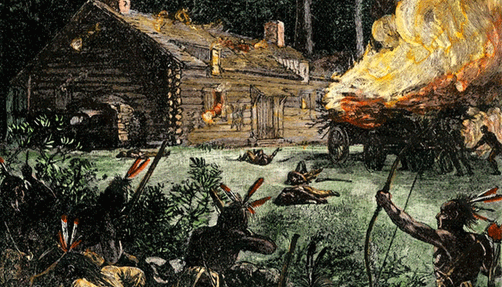
The simplified narrative implies the land was vacant or willingly given up. In reality, while Native communities did not practice the concept of "private property" as the Europeans did (they held community property, as noted by Silverman), they initially thought the English were merely buying into Wampanoag country, not attempting to take it over entirely.
The subsequent colonial expansion was met with strong resistance, resulting in the devastating King Philip’s War, which ultimately allowed settlers to solidify their control over the territory.
Myth #5: The feast featured turkey and pumpkin pie.
Truth: It is extremely unlikely that the items we consider Thanksgiving staples—namely whole turkey, cranberry sauce, and pumpkin or other sweet pies—were served at the 1621 feast.
As documented in historical deep dives like 1621: A New Look at Thanksgiving by Catherine O’Neill Grace, the menu likely centered on deer (venison), which the Wampanoag contributed, as well as fowl (likely ducks or geese), and local seafood.
Wheat flour and refined sugar, necessary for items like pie crusts and sweet desserts, were luxury goods that would have been scarce or non-existent in the early settlement.
Dive deeper with recommended reading!
To further understand the complex historical reality behind common Thanksgiving myths, we highly recommend reading the works cited in this article, compiled below.
These books offer invaluable perspectives on Wampanoag history, colonial relations, and the careful construction of the American historical narrative.
Sources and Further Reading
- Grace, Catherine O’Neill. 1621: A New Look at Thanksgiving. National Geographic, 2001.
- Lincoln, Abraham. Proclamation of Thanksgiving. October 3, 1863. (Formalized the national holiday during the Civil War.)
- Loewen, James W. Lies My Teacher Told Me: Everything Your American History Textbook Got Wrong. Touchstone, 1995.
- Library of Congress (LOC). "A Presidential History of Thanksgiving." Headlines and Heroes Blog. November 23, 2021. Link: https://blogs.loc.gov/headlinesandheroes/2021/11/a-presidential-history-of-thanksgiving/
- Pestana, Carla Gardina. The World of Plymouth Plantation. University Press of New England, 2018.
- Silverman, David J. This Land is Their Land: The Wampanoag Indians, Plymouth Colony, and the Troubled History of Thanksgiving. Knopf, 2019.
- Smithsonian Magazine. "The Thanksgiving Myth and What We Should Be Teaching Kids." November 20, 2017. Link to article: https://www.smithsonianmag.com/history/thanksgiving-myth-and-what-we-should-be-teaching-kids-180973655/
- Smithsonian Magazine. "Why the Myths of Plymouth Dominate the American Imagination." November 20, 2020. Link to article: https://www.smithsonianmag.com/history/why-myths-plymouth-dominate-american-imagination-180976396/
